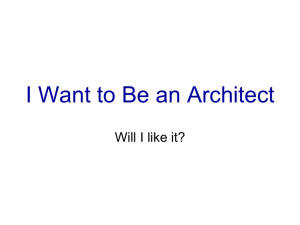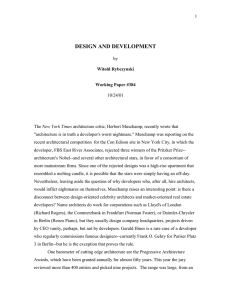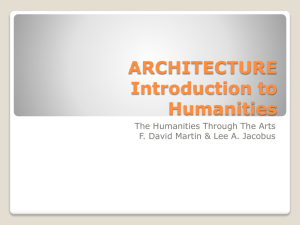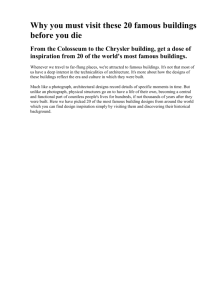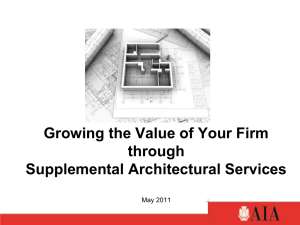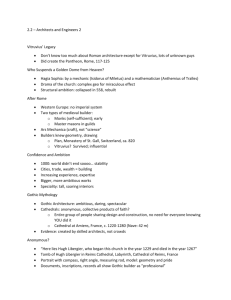Modern Architecture
advertisement
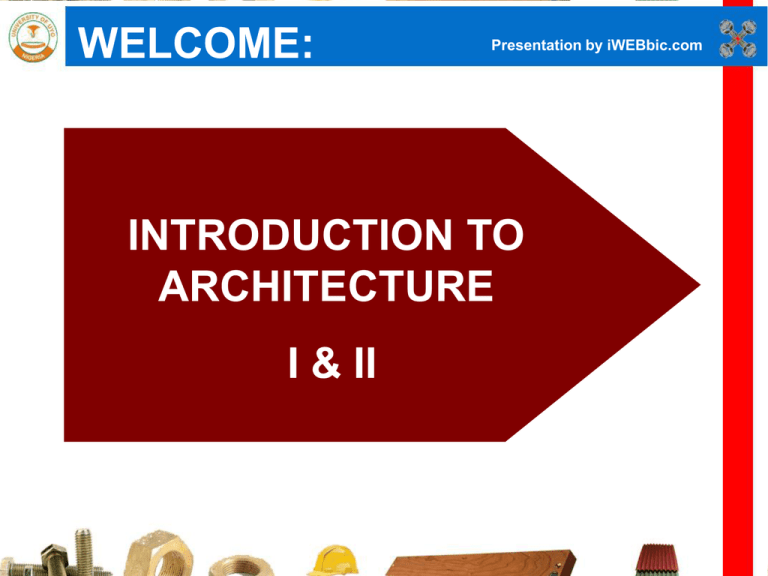
WELCOME: Presentation by iWEBbic.com INTRODUCTION TO ARCHITECTURE I & II Lecture Guide – Architecture 101 Introduction to Architecture What is Architecture History of Architecture Historic Elements of Architecture Ancient Architecture Islamic Architecture Medieval and Gothic Architecture Early modern and Industrial age Architecture Modern Architecture (Overview) Presentation by iWEBbic.com Introduction to Architecture What is Architecture? Architecture (Latin architectura, from the Greek ἀρχιτέκτων – arkhitekton, from ἀρχι- "chief" and τέκτων "builder, carpenter, mason") is both the process and product of planning, designing, and construction, usually of buildings and other physical structures. Architectural works, in the material form of buildings, are often perceived as cultural symbols and as works of art. Historical civilizations are often identified with their surviving architectural achievements. Architecture can be defined briefly as: A general term to describe buildings and other physical structures. The art and science of designing and erecting buildings and other physical structures. The style and method of design and construction of buildings and other physical structures. The practice of the architect, where architecture means the offering or rendering of professional services in connection with the design and construction of buildings, or built environments The design activity of the architect, from the macro-level (urban design, landscape architecture) to the micro-level (construction details and furniture). The activity of designing any kind of system, and is commonly used in describing information technology. Presentation by iWEBbic.com History of Architecture Historic Elements of Architecture The Parthenon The earliest surviving written work on the subject of architecture is De architectura, by the Roman architect Vitruvius in the early 1st century AD. According to Vitruvius, a good building should satisfy the three principles of firmitas, utilitas, venustas, which translate roughly as – • Durability – it should stand up robustly and remain in good condition. • Utility – it should be useful and function well for the people using it. • Beauty – it should delight people and raise their spirits. The Parthenon is located in Athens, Greece. Considered a classic example of Greek Architecture, The Parthenon was built to represent the gods and goddesses in abstract form. The Greeks built their structures using mathematical proportions and considered their buildings as a type of sculpture. Presentation by iWEBbic.com History of Architecture The National Gallery of Art West Wing Building first evolved out of the dynamics between needs (shelter, security, worship, etc.) and means (available building materials and attendant skills). As human cultures developed and knowledge began to be formalized through oral traditions and practices, building became a craft, and "architecture" is the name given to the most highly formalized and respected versions of that craft. Built in 1941 it is an example of neo-classical architecture. Neoclassical architecture is architecture inspired by the buildings designed and created during Ancient Greece and Rome. Neo-classical architecture uses some if not all of these styles in its design: symmetry, columns, triangular pediments, and/or domes. Presentation by iWEBbic.com History of Architecture Ancient Architecture In many ancient civilizations, such as those of Egypt and Mesopotamia, architecture and urbanism reflected the constant engagement with the divine and the supernatural, and many ancient cultures resorted to monumentality in architecture to represent symbolically the political power of the ruler, the ruling elite, or the state itself. The architecture and urbanism of the Classical civilizations such as the Greek and the Roman evolved from civic ideals rather than religious or empirical ones and new building types emerged. Architectural "style" developed in the form of the Classical orders. Texts on architecture have been written since ancient time. These texts provided both general advice and specific formal prescriptions or canons. Some examples of canons are found in the writings of the 1st-century BCE Roman military engineer Vitruvius. Some of the most important early examples of canonic architecture are religious. Presentation by iWEBbic.com History of Architecture Islamic Architecture Islamic architecture began in the 7th century CE, incorporating architectural forms from the ancient Middle East and Byzantium, but also developing features to suit the religious and social needs of the society. Examples can be found throughout the Middle East, North Africa, Spain and the Indian Subcontinent. The widespread application of the pointed arch was to influence European architecture of the Medieval period. The Taj Mahal in India The Taj Mahal, "crown of palaces", is a white marble mausoleum located in Agra, Uttar Pradesh, India. It was built by Mughal emperor Shah Jahan in memory of his third wife, Mumtaz Mahal. The Taj Mahal is widely recognized as "the jewel of Muslim art in India and one of the universally admired masterpieces of the world's heritage Presentation by iWEBbic.com History of Architecture Medieval & Gothic Architecture Notre Dame Cathedral In Europe, in both the Classical and Medieval periods, buildings were not often attributed to specific individuals and the names of architects remain frequently unknown, despite the vast scale of the many religious buildings extant from this period. During the Medieval period guilds were formed by craftsmen to organize their trade and written contracts have survived, particularly in relation to ecclesiastical buildings. The role of architect was usually one with that of master mason, or Magister lathomorum as they are sometimes described in contemporary documents. Notre-Dame de Paris for "Our Lady of Paris", also known as Notre-Dame Cathedral or simply Notre-Dame, is a historic Roman Rite Catholic Marian cathedral on the eastern half of the Île de la Cité in the fourth arrondissement of Paris, France. Presentation by iWEBbic.com History of Architecture Early Modern and the Industrial Age Architecture With the emerging knowledge in scientific fields and the rise of new materials and technology, architecture and engineering began to separate, and the architect began to concentrate on aesthetics and the humanist aspects, often at the expense of technical aspects of building design. There was also the rise of the "gentleman architect" who usually dealt with wealthy clients and concentrated predominantly on visual qualities derived usually from historical prototypes, typified by the many country houses of Great Britain that were created in the Neo Gothic or Scottish Baronial styles. Formal architectural training in the 19th century, for example at Ecole des Beaux Arts in France, gave much emphasis to the production of beautiful drawings and little to context and feasibility. Effective architects generally received their training in the offices of other architects, graduating to the role from draughtsmen or clerks. Meanwhile, the Industrial Revolution laid open the door for mass production and consumption. Aesthetics became a criterion for the middle class as ornamented products, once within the province of expensive craftsmanship, became cheaper under machine production. Vernacular architecture became increasingly ornamental. House builders could use current architectural design in their work by combining features found in pattern books and architectural journals. Presentation by iWEBbic.com Modern Architecture Modern Architecture Around the turn of the 20th century, a general dissatisfaction with the emphasis on revivalist architecture and elaborate decoration gave rise to many new lines of thought that served as precursors to Modern Architecture. Notable among these is the Deutscher Werkbund, formed in 1907 to produce better quality machine made objects. The rise of the profession of industrial design is usually placed here. Following this lead, the Bauhaus school, founded in Weimar, Germany in 1919, redefined the architectural bounds prior set throughout history, viewing the creation of a building as the ultimate synthesis—the apex—of art, craft, and technology. When Modern architecture was first practiced, it was an avant-garde movement with moral, philosophical, and aesthetic underpinnings. Immediately after World War I, pioneering modernist architects sought to develop a completely new style appropriate for a new post-war social and economic order, focused on meeting the needs of the middle and working classes. They rejected the architectural practice of the academic refinement of historical styles which served the rapidly declining aristocratic order. The approach of the Modernist architects was to reduce buildings to pure forms, removing historical references and ornament in favor of functionalist details. Buildings displayed their functional and structural elements, exposing steel beams and concrete surfaces instead of hiding them behind decorative forms. Presentation by iWEBbic.com Modern Architecture Introduction to Modern Architecture As the 20th century began modern architects believed it was necessary to invent an architecture that expressed the spirit of a new age and would surpass the styles, materials, and technologies of earlier architecture Their aesthetic celebrated function in all forms of design, household furnishings, ocean liners and new flying machines Modern architecture also challenged traditional ideas about the types of structures suitable for architectural design Important civic buildings, aristocratic palaces, churches, and public institutions had long been the mainstay of architectural practices, but modernist designers argued that architects should design all that was necessary for society, even the most humble buildings Presentation by iWEBbic.com Modern Architecture Points to Note Modern Architecture, the buildings and building practices of the late 19th and the 20th centuries Modern architects reacted against the architecture of the 19th century, which they felt borrowed too heavily from the past Italian architect Antonio Sant'Elia resoundingly rejected traditional architecture in his Futurist Manifesto of 1914 (Futurism) He called for each generation to build its houses anew and celebrated glass, steel, and concrete as the materials to make this possible In the United States Frank Lloyd Wright also rejected 19th-century European architecture Developments in two materials—iron and concrete—formed the technological basis for much modern architecture Steel for construction also became abundantly available in the 19th century In 1892 French engineer François Hennebique combined the strengths of both in a new system of construction based on concrete reinforced with steel His invention made possible previously unimaginable effects: extremely thin walls with large areas of glass Architects in Chicago, Illinois, were the first to exploit the possibilities offered by the elevator in combination with the new steel and concrete technologies Presentation by iWEBbic.com Modern Architecture Modern Architecture Tower Bridge Built between 1886 and 1894, bridge on the Thames River in London, near the Tower of London, one of the city's principal landmarks It was the only movable bridge crossing the Thames when it was completed in 1894. Sir Horace Jones designed the bridge, and Sir John Wolfe Barry built it 150,000 vehicles cross it every day. Over 900 times a year the roadway parts and lifts to let tall ships, cruise liners and other large craft pass through. Presentation by iWEBbic.com Modern Architecture Modern Architecture Sydney Opera House Major performing arts center on the harbor in Sydney, Australia, regarded as the finest modern building in the country; completed 1973 Designed by Danish architect Jørn Utzon, who won an international competition for the project in 1956 Distinctive sail-shaped towers were pronounced unbuildable by a British engineering firm, redesigned at a lower angle Utzon then resigned from the project, and the building was completed by the engineering firm in 1973 Concert hall, theater for opera and ballet, smaller theater for plays, recording hall and rehearsal rooms, and movie theater Presentation by iWEBbic.com Modern Architecture Empire State Building Modern Architecture New York City, skyscraper located on 5th Avenue Tallest building in the world when completed in 1931 (381 m) Because of its elegant stepped design it is often still regarded as the ultimate American skyscraper Designed by the American architectural firm of Shreve, Lamb & Harmon in a streamlined art deco style, the Empire State Building consists of 102 stories of office space A radio and television mast that was added in 1951 A model of the building was used in the 1933 version of the motion picture King Kong, in the sequence in which the giant ape clings to its upper stories while fighting off squadrons of fighter planes Presentation by iWEBbic.com THE END OF LECTURE: INTRODUCTION TO ARCHITECTURE I & II Read About Renaissance Architecture. Make a summary of your findings and submit it next week. Thank You for Your Time Presentation by iWEBbic.com
